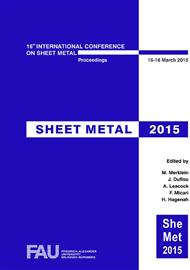p.123
p.131
p.139
p.147
p.155
p.163
p.173
p.179
p.187
On the Identification of a Loading Scheme in Large Radius Air Bending
Abstract:
Large radius air bending has a different loading diagram than conventional bending, which affects the material behavior during the bending process. In order to establish a correct loading diagram, the position of the contact points between the plate and the punch is determinant. The position of the contact points is depending on the evolution of the bending process and the influence of the material is unknown. In this work, the determination of the position of the contact points in large radius air bending has been studied by means of both an experimental campaign and finite element analysis. Experiments were performed on a press-brake with a capacity of 50 metric tons. High-strength steel Weldox 1300 and aluminum alloy AlMg3, and punches of radii 30, 35 and 40 mm have been used. During the bending process, the punch movement has been monitored and the bending angle has been measured by means of images recorded by a camera system. Based on the obtained results, the relation between the bending angle and the position of the contact points is discussed.
Info:
Periodical:
Pages:
155-162
Citation:
Online since:
March 2015
Authors:
Price:
Сopyright:
© 2015 Trans Tech Publications Ltd. All Rights Reserved
Share:
Citation:


